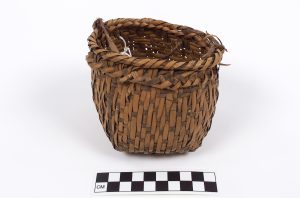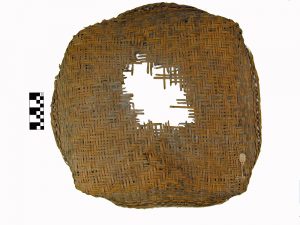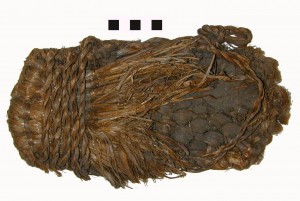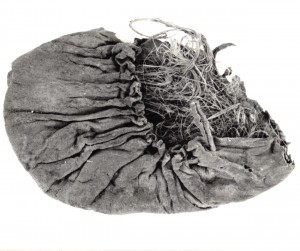Another type of perishable item found in the bluff shelter collections are textiles—twisted and woven fiber used to make many items, including things such as baskets, bags, clothing, and shoes. These items would have made up much of the material culture of everyday life in the prehistoric Ozarks.
Dr. Elizabeth Horton’s research examines fabric traditions and fiber use in the Ozarks and greater southern United States. Her dissertation is an encyclopedic examination of the perishable materials recovered from dry Ozark bluff shelters. Now, as the Arkansas Archeological Survey Research Station Archeologist at Toltec Mounds State Park, she continues her work on basketry, textiles, and the cultural use of plants—including their roles in the sacred lives of prehistoric Native American women.
Baskets

In a world before ceramics, baskets were incredibly important. Along with dried gourds, they were the only way to store objects or food. They were used for cooking, and to transport items. The earliest radiocarbon dates for basketry in the Ozarks are from the Archaic period but basketry continues to be an important part of Native American life even today. There are two main types of basketry recovered from bluff shelter contexts and each can tell us something about the history of the people who created and used them.
One type of basket found in bluff shelters is the coiled basket. A coiled basket like the one pictured here is made by coiling a bundle of fiber in a spiral shape while stitching it to the other parts of the bundle as you work out from the center. There are several variations of this technique represented in the Ozark bluff shelter materials. Dr. Elizabeth Horton, among others, sees the coiled basketry tradition in the Ozarks as being related to similar traditions in the Great Basin, Southwest, and northern Mexico. Coiled baskets in these regions predate the earliest dated example in the Ozarks, and since it is unlikely that this technology evolved independently in more than one place, this implies contact between the regions in the Archaic period. The form evolved through time and shows evidence of further influence from outside sources in the Woodland period.
This type of basket would have been used for food storage but also for cooking. Tasks such as the parching of nuts and seeds would have taken place in coiled baskets.


The second type of basket found in bluff shelters is the interlaced variety, which can be made of either cane, bark, or wood. The earliest direct dates on this type of basket in bluff shelter contexts puts them in the Archaic period as well. Early examples of interlaced baskets are bowl-like in form with oval tops and squarish bases. In the Middle to Late Woodland the balance of baskets shifts to a new form—a low walled tray basket. These baskets come in two varieties, one is a loose weave and the other is a tighter weave. These seem to be used in the winnowing and parching of grains. They appear to become more important as agriculture, and particularly corn agriculture, becomes more important. Baskets almost identical to the ones in the bluff shelter collections—for example, this one from Cob Cave—are still being made by Native American weavers today. The modern baskets are used to process corn just as we assume was happening in the past.
Bags
Several examples of woven bags have been found in the shelter materials. These bags seem to be designed to hold food like nuts and seeds. Many examples have been found with the contents still inside. One example is the Edens Bluff seed bag which contained about a liter of chenopodium seeds. Others have been found containing acorns or corn cobs. One example found by M. R. Harrington did not contain seeds but personal, or possibly ceremonial, items. It held two beaver teeth, the beak and bones of a bird, and worked pieces of calcite, hematite, and crystal.

The form of the bags seems to follow their function. Earlier bags designed to hold larger objects like acorns were made with plied or twisted fibers, giving more spaces in the weave of the bag. The later Woodland examples have a design that could hold large quantities of very small seeds like chenopodium or amaranth. These examples are made of bunched rather than twisted fibers which would have held the small seeds more securely. Later still, after the shift to corn agriculture, the weave of the bags became more relaxed again.
Shoes

One of the remarkable aspects about preservation in the Ozark bluff shelters is that there have been enough shoes recovered, whole or at least partially intact, to allow researchers to describe changes in styles over time. Although there may have been some sewn leather shoes in the Woodland period, and perhaps even in the Archaic, the majority of the shoes from these earlier time periods have been made using plant fiber—specifically the leaves of a plant known as “Rattlesnake Master” (Eryngium yuccifolium). This plant was critical in the production of many types of perishable artifacts, from bags to blankets to shoes, for at least 8000 years in the southeastern United States. Carefully tailored “moccasins” of well-tanned deer hide seem to be a late prehistoric shoe style, based on a radiocarbon date on an example from a cave in Missouri, the associated artifacts from shelters in the Ozark Plateau where this style is found, and iconographic images of people on engraved shell and embossed copper artifacts. However, it is likely that people continued to make and wear woven plant fiber sandals and shoes, at least occasionally, well into the late prehistoric period.
